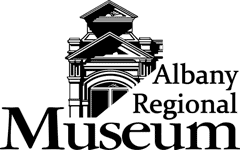By Cathy Ingalls, Albany Regional Museum board member
Evelyn Burleson maps strategy in the sand with two students. Albany Regional Museum photo collection: 2007.015.634
This year, the Albany Municipal Airport marks its 99th year, making it the oldest continuously operating airfield in the state.
Along with that designation, in June 1998, the National Park Service in Washington, D.C., notified the city that the airport east of Albany had been selected for the National Register of Historic Places. The city was assured that the designation would not interfere with daily airport operations.
The city owns and controls the airport.
The listing protects the airport to some degree from any federally sponsored project that could disturb the property, said Elizabeth Potter, who in 1998 was the nominations coordinator for the State Historic Preservation Office.
Currently, the airport is somewhat protected by state land-use laws and the city’s preservation ordinances.
In addition to the assurances of protection, the national listing qualifies a property for grants to help pay for feasibility or engineering studies related to restoration.
The 58.77 acres encompassed in the nomination included the main hangar built in 1920, which is the oldest building at the airport, according to a news story that appeared in the Albany Democrat-Herald.
At the time of the application, Potter said that the hangar besides its age, was impressive because of its full span of arched wood trusses that support the roof. The lattice trusses that appear to be made of unfinished redwood measure 80 feet by 100 feet and are 20 feet tall.
According to news stories, the hangar was constructed on an elevated, 100-acre wheat field by U.G. Hayne for $7,435.
The hangar is not in its original location but was moved to its current site when Interstate 5 was built in 1957-58. The location is on the original north-south runway.
Albany pilots Ed Hemmingson and Dan Miltenberger spearheaded the effort to get the airport named to the register.
The two, along with other pilots, wanted the designation to help prevent interested groups at the time from creating a commercial site on the property.
According to the Democrat-Herald, Albany has had a long association with flight.
Henry Flindt launched a self-propelled, steam-powered ornithopter from the second story roof of his home at Fourth Avenue and Montgomery Street. Reports indicate that the machine crashed.
The first hot air balloons to fly in the state outside of Portland, lifted off from Albany in 1886.
The first experimental glider took off from the roof of a house at Third and Montgomery. The glider crashed, and the pilot broke his legs.
In 1910, Cornell University graduate John C. Burkhart, cousin Del Burkhart and William C. Crawford built a “run-in” and a hangar, making the airfield public. That airfield was constructed at Goltra Field, which lay between the railroad tracks, Queen Avenue and Ferry and Howard streets. John Burkhart had visited the Wright Brothers at Kitty Hawk and watched them fly, instilling in him the desire to build a plane of his own.
The current airport became a reality when 13-year-old Charles Langmack of Lebanon landed on the Sternberge wheat field in 1920 in a Canadian-built, World War I surplus JN-4 or “Canuck.” Langmack rented the wheat field, which the city purchased in 1929, and named it the Albany Municipal Airport.
The airport was dedicated in 1931. The event included an air show attended by about 12,000 people.
In 1937, Evelyn Burleson set up a flight school, graduating about 250 pilots before leaving the area.
The American Legion Post sponsored the largest air circus in the West at the airport in 1939, attracting 63 airplanes and about 5,000 spectators.
In 1964, a jet landed at the Albany airport for the first time.
The Northwest Art & Air Festival is held every summer at the airport and Timber-Linn Memorial Park nearby.
There is a file about the airport at the Albany Regional Museum. And Executive Director Keith Lohse has an historical account of the airport in his office that was put together by Ed Hemmingson.
The museum at 136 Lyon St. S is open from 11 a.m. to 4 p.m. Tuesday through Friday and from 10 a.m. to 2 p.m. Saturday.
For more information, call 541-967-7122 or visit www.armuseum.com.

